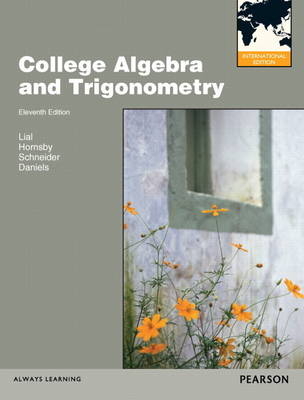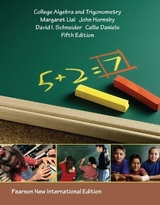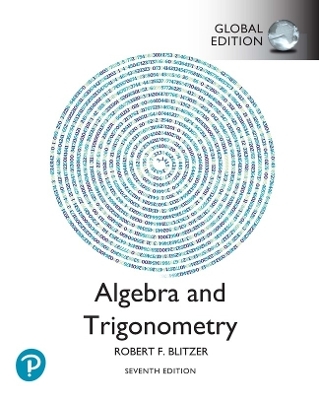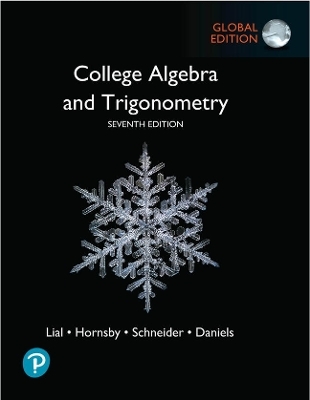
College Algebra and Trigonometry, plus MyMathLab
Pearson Education Limited
978-1-4479-3620-6 (ISBN)
- Titel erscheint in neuer Auflage
- Artikel merken
College Algebra and Trigonometry, Fifth Edition, by Lial, Hornsby, Schneider, and Daniels, engages and supports students in the learning process by developing both the conceptual understanding and the analytical skills necessary for success in mathematics. With the Fifth Edition, the authors adapt to the new ways in which students are learning, as well as the ever-changing classroom environment.
MyLab and Mastering from Pearson improve results for students and educators. Used by over ten million students, they effectively engage learners at every stage.
MyMathLab is being used in universities all over the world to improve student performance. MyMathLab has immersive content and engaging tools, along with time-saving automatic grading. "MyMathLab is everything that I need to get good results from my students. ... It saves me a lot of time so I have more time to do what I really should do and that's teach and help my students." - Dr Morten Brekke, Agder University, Norway.
With MyMathLab, students gain knowledge that they will use throughout their lives, and universities gain a partner deeply committed to helping students and educators achieve their goals.
For students
Personalised study plan: MyMathLab gives you the opportunity to test yourself on key concepts and skills and generates a study plan based on topics you have not yet mastered. The study plan links to interactive exercises with guidance, to give you help when you need it most.
Pearson eText gives you access to an eBook that can be used on the go, and allows you to highlight, search and take notes as you read online. Access to the eBook depends on the package you have bought.
Help Me Solve This breaks the problem down into manageable chunks so you can work through the methodology a stage at a time, applying what you've learnt as you go along.
The questions are free response so you can give truly mathematical answers using the intuitive yet comprehensive maths palette or the graphing tool.
For educators
Online assignments, tests, quizzes can be easily created and assigned to students.
Gradebook: Assignments are automatically graded and visible at a glance.
Register now to benefit from these resources.
A student access code card is included with your textbook at a reduced cost. To register with your code, visit www.mymathlab.co.uk.
For educator access, contact your Pearson account manager. To find out who your account manager is, visit www.pearsoned.co.uk/replocator
For more instructor resources available with this title, visit www.pearsoned.co.uk
Marge Lial has always been interested in math; it was her favorite subject in the first grade! Marge's intense desire to educate both her students and herself has inspired the writing of numerous best-selling textbooks. Marge, who received Bachelor's and Master's degrees from California State University at Sacramento, is now affiliated with American River College. Marge is an avid reader and traveler. Her travel experiences often find their way into her books as applications, exercise sets, and feature sets. She is particularly interested in archeology. Trips to various digs and ruin sites have produced some fascinating problems for her textbooks involving such topics as the building of Mayan pyramids and the acoustics of ancient ball courts in the Yucatan. When John Hornsby enrolled as an undergraduate at Louisiana State University, he was uncertain whether he wanted to study mathematics education or journalism. His ultimate decision was to become a teacher, but after twenty-five years of teaching at the high school and university levels and fifteen years of writing mathematics textbooks, both of his goals have been realized. His love for both teaching and for mathematics is evident in his passion for working with students and fellow teachers as well. His specific professional interests are recreational mathematics, mathematics history, and incorporating graphing calculators into the curriculum. John's personal life is busy as he devotes time to his family (wife Gwen, and sons Chris, Jack, and Josh). He has been a rabid baseball fan all of his life. John's other hobbies include numismatics (the study of coins) and record collecting. He loves the music of the 1960s and has an extensive collection of the recorded works of Frankie Valli and the Four Seasons. David Schneider has taught mathematics at universities for over 34 years and has authored 36 books. He has an undergraduate degree in mathematics from Oberlin College and a PhD in mathematics from MIT. During most of his professional career, he was on the faculty of the University of Maryland--College Park. His hobbies include travel, dancing, bicycling, and hiking. Callie Daniels has always had a passion for learning mathematics and brings that passion into the classroom with her students. She attended the University of the Ozarks on an athletic scholarship, playing both basketball and tennis. While there, she earned a bachelor's degree in Secondary Mathematics Education as well as the NAIA Academic All-American Award. She has two master's degrees: one in Applied Mathematics and Statistics from the University of Missouri-Rolla, the second in Adult Education from the University of Missouri- St. Louis. Her hobbies include watching her sons play sports, riding horses, fishing, shooting photographs, and playing guitar. Her professional interests include improving success in the community college mathematics sequence, using technology to enhance students' understanding of mathematics, and creating materials that support classroom teaching and student understanding.
R. Review of Basic Concepts
R.1 Sets
R.2 Real Numbers and Their Properties
R.3 Polynomials
R.4 Factoring Polynomials
R.5 Rational Expressions
R.6 Rational Exponents
R.7 Radical Expressions
1. Equations and Inequalities
1.1 Linear Equations
1.2 Applications and Modeling with Linear Equations
1.3 Complex Numbers
1.4 Quadratic Equations
1.5 Applications and Modeling with Quadratic Equations
1.6 Other Types of Equations and Applications
1.7 Inequalities
1.8 Absolute Value Equations and Inequalities
2. Graphs and Functions
2.1 Rectangular Coordinates and Graphs
2.2 Circles
2.3 Functions
2.4 Linear Functions
2.5 Equations of Lines and Linear Models
2.6 Graphs of Basic Functions
2.7 Graphing Techniques
2.8 Function Operations and Composition
3. Polynomial and Rational Functions
3.1 Quadratic Functions and Models
3.2 Synthetic Division
3.3 Zeros of Polynomial Functions
3.4 Polynomial Functions: Graphs, Applications, and Models
3.5 Rational Functions: Graphs, Applications, and Models
3.6 Variation
4. Inverse, Exponential, and Logarithmic Functions
4.1 Inverse Functions
4.2 Exponential Functions
4.3 Logarithmic Functions
4.4 Evaluating Logarithms and the Change-of-Base Theorem
4.5 Exponential and Logarithmic Equations
4.6 Applications and Models of Exponential Growth and Decay
5. Trigonometric Functions
5.1 Angles
5.2 Trigonometric Functions
5.3 Evaluating Trigonometric Functions
5.4 Solving Right Triangles
6. The Circular Functions and Their Graphs
6.1 Radian Measure
6.2 The Unit Circle and Circular Functions
6.3 Graphs of the Sine and Cosine Functions
6.4 Translations of the Graphs of the Sine and Cosine Functions
6.5 Graphs of the Tangent, Cotangent, Secant, and Cosecant
6.6 Harmonic Motion
7. Trigonometric Identities and Equations
7.1 Fundamental Identities
7.2 Verifying Trigonometric Identities
7.3 Sum and Difference Identities
7.4 Double-Angle and Half-Angle Identities
7.5 Inverse Circular Functions
7.6 Trigonometric Equations
7.7 Equations Involving Inverse Trigonometric Functions
8. Applications of Trigonometry
8.1 The Law of Sines
8.2 The Law of Cosines
8.3 Vectors, Operation, and the Dot Product
8.4 Applications of Vectors
8.5 Trigonometric (Polar) Form of Complex Numbers; Products and Quotients
8.6 De Moivre's Theorem; Powers and Roots of Complex Numbers
8.7 Polar Equations and Graphs
8.8 Parametic Equations, Graphs, and Applications
9. Systems and Matrices
9.1 Systems of Linear Equations
9.2 Matrix Solution of Linear Systems
9.3 Determinant Solution of Linear Systems
9.4 Partial Fractions
9.5 Nonlinear Systems of Equations
9.6 Systems of Inequalities and Linear Programming
9.7 Properties of Matrices
9.8 Matrix Inverses
10. Analytic Geometry
10.1 Parabolas
10.2 Ellipses
10.3 Hyperbolas
10.4 Summary of the Conic Sections
11. Further Topics in Algebra
11.1 Sequences and Series
11.2 Arithmetic Sequences and Series
11.3 Geometric Sequences and Series
11.4 The Binomial Theorem
11.5 Mathematical Induction
11.6 Counting Theory
11.7 Basics of Probability
Appendices
Appendix A. Polar Form of Conic Sections
Appendix B. Rotation of Axes
Appendix C. Geometry Formulas
Glossary
Solutions to Selected Exercises
Answers to Selected Exercises
Index of Applications
Index
Photo Credits
| Verlagsort | Harlow |
|---|---|
| Sprache | englisch |
| Maße | 213 x 275 mm |
| Gewicht | 2210 g |
| Themenwelt | Mathematik / Informatik ► Mathematik ► Algebra |
| Mathematik / Informatik ► Mathematik ► Geometrie / Topologie | |
| ISBN-10 | 1-4479-3620-5 / 1447936205 |
| ISBN-13 | 978-1-4479-3620-6 / 9781447936206 |
| Zustand | Neuware |
| Haben Sie eine Frage zum Produkt? |
aus dem Bereich


